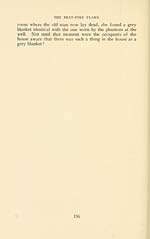Ossian Collection > Peat-fire flame
(199)
Download files
Complete book:
Individual page:
Thumbnail gallery: Grid view | List view

CHAPTER XIII
BELL LORE
RECORDS of sacred bells are scanty. But it is well
known that in certain parts of Scotland there
, existed bells, to which were ascribed healing and
protecting properties, such as were possessed by the water
of certain wells and springs. The general belief was that
such bells, when stolen or otherwise removed from their
rightful place, had the power of returning of their own
accord. The same power was said to be vested in a
wonderful hachall or crosier belonging to the godly St.
Moluag. This crosier was entrusted to a hereditary
custodian who, in respect of his services as keeper, was
endowed with a freehold in the Trotternish region of Skye.
St. Moluag's crosier had the power of healing
whomsoever touched it, or was touched by it. When the
saint died, in the latter half of the seventh century, one of
his apostles took the crosier with him from Lismore to
Appin, whither he had journeyed to minister to a dying
man. In his haste to re-cross to Lismore, so as to avoid
an impending storm, he arrived back without St. Moluag's
magic crosier; but, just as he was about to step on the
threshold of the church, something whizzed past his ear.
What was this but the hachall returning of its own accord
to the proper place in the church ! In common with many
small bells that, on account of their healing powers, were
used either privately or in churches, this crosier had the
miraculous power of finding its way back in the event
of its being stolen or forgotten. The touch of a
hachall and the sound of such a bell were held, alike, to heal
afflicted persons by dispelling the evil spirits of which they
were possessed. St. Moluag's crosier wrought many cures
'157
BELL LORE
RECORDS of sacred bells are scanty. But it is well
known that in certain parts of Scotland there
, existed bells, to which were ascribed healing and
protecting properties, such as were possessed by the water
of certain wells and springs. The general belief was that
such bells, when stolen or otherwise removed from their
rightful place, had the power of returning of their own
accord. The same power was said to be vested in a
wonderful hachall or crosier belonging to the godly St.
Moluag. This crosier was entrusted to a hereditary
custodian who, in respect of his services as keeper, was
endowed with a freehold in the Trotternish region of Skye.
St. Moluag's crosier had the power of healing
whomsoever touched it, or was touched by it. When the
saint died, in the latter half of the seventh century, one of
his apostles took the crosier with him from Lismore to
Appin, whither he had journeyed to minister to a dying
man. In his haste to re-cross to Lismore, so as to avoid
an impending storm, he arrived back without St. Moluag's
magic crosier; but, just as he was about to step on the
threshold of the church, something whizzed past his ear.
What was this but the hachall returning of its own accord
to the proper place in the church ! In common with many
small bells that, on account of their healing powers, were
used either privately or in churches, this crosier had the
miraculous power of finding its way back in the event
of its being stolen or forgotten. The touch of a
hachall and the sound of such a bell were held, alike, to heal
afflicted persons by dispelling the evil spirits of which they
were possessed. St. Moluag's crosier wrought many cures
'157
Set display mode to: Large image | Transcription
Images and transcriptions on this page, including medium image downloads, may be used under the Creative Commons Attribution 4.0 International Licence unless otherwise stated. ![]()
| Early Gaelic Book Collections > Ossian Collection > Peat-fire flame > (199) |
|---|
| Permanent URL | https://digital.nls.uk/81148447 |
|---|
| Description | Selected books from the Ossian Collection of 327 volumes, originally assembled by J. Norman Methven of Perth. Different editions and translations of James MacPherson's epic poem 'Ossian', some with a map of the 'Kingdom of Connor'. Also secondary material relating to Ossianic poetry and the Ossian controversy. |
|---|
| Description | Selected items from five 'Special and Named Printed Collections'. Includes books in Gaelic and other Celtic languages, works about the Gaels, their languages, literature, culture and history. |
|---|

